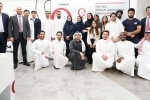Tourism and aviation industry players have plenty of reasons to collaborate. That’s particularly relevant in the GCC, where tourism authorities, airports, and airlines already are enjoying a healthy increase in inbound travel and have set aggressive goals to make the region even more of a tourist magnet in the future. To do that, they need to capitalize on the surge in leisure travel and respond to growing competition among leisure travel destinations. For GCC countries, tourism also represents an opportunity to diversify a traditionally oil-based economy.
Despite their ambitious goals, however, tourism and aviation players often work in isolation rather than teaming up. Or they combine for one-off projects instead of adopting a considered, coordinated, long-term approach.
With greater cooperation, the tourism and aviation sectors in GCC countries could accomplish more than they could alone because of their commonalities and inherently symbiotic relationship. National tourism promotion entities and airlines could, for example, jointly identify tourist source markets with the most growth potential. Regional or local destination management organizations could work with airlines and airports to market their respective areas. Or they could jointly develop travel packages and marketing to attract leisure travelers, families, or other target visitor segments. Working together, these partners could align investments in future projects to ensure that air, ground, and accommodation infrastructure supports the targeted increase in visitors, and provides tourists with a seamless, enjoyable experience in line with their preferences.
While the reasons for working together are compelling, implementing them is complex. To generate the greatest impact, collaboration should start before and continue through the entire visitor journey. Partners must be willing to pool their respective traveler data and insights to identify high-potential markets. They must agree to establish or expand routes to those tourist source markets to ensure there is sufficient capacity to accommodate anticipated tourism growth. They must agree on joint marketing and promotional campaigns to promote high-priority destinations, including jointly promoting travel packages and using each other’s distribution channels.
Successful collaboration between tourism and aviation sector players can take several forms. Committees are the most common. Another option is to create a working group that focuses on specific topics such as marketing, distribution, and product development. Or parties can collaborate under a single, joint leadership.
Regardless of the form, successful collaborations typically are specific to a destination or can be created at the country level. They can include members from all corners of the tourism sector, including the major airport in the area, and the key airlines that serve it. Larger groups or committees also may include as members government representatives, including from aviation regulators, regional development authorities, and immigration authorities, along with executives from the hospitality, food and beverage, and real estate industries.
Singapore’s long-term success shows how cooperation results in growth. Since Singapore Airlines, the Singapore Tourism Board, and Changi Airport Group teamed up more than 15 years ago, the group has run multi-million-dollar campaigns to produce billboards, online and TV ads, and short films for social media and inflight entertainment systems.i Marketing and ads promote Singapore as a travel destination, top stopover city, and budget-conscious “twin” destination of more popular, costly locales.
In addition to promotions, the group has jointly developed specific travel packages with curated offerings for leisure travelers and the meetings, incentives, conference, and events market. They have collaborated on free tours of Singapore for passengers in transit to other destinations – to give them enough of a taste of the area to want to return for a longer stay. They also have cooperated to renovate and expand a wildlife park in Singapore’s Mandai precinct, turning it into a major tourist attraction.
Joint leadership has been vital for coordinating activities. For example, Changi Airport Group CEO Lee Seow Hiang sits on the Singapore Tourism Board.ii The results of the group’s efforts have contributed significantly to Singapore’s long-term tourism growth and assisted in its post-pandemic recovery. Between 2009 and 2019, the number of international visitors to Singapore almost doubled.iii In 2023, international tourist numbers reached 13.6 million.iv
To enjoy similar success, tourism and aviation partners in GCC countries should establish a governance structure that works for their particular situation, with clear lines of authority and decision-making.
In addition, partnerships must develop integrated plans that align with long-term strategic objectives and short-term operational goals across functions such as product development, marketing, airline route expansion, and capacity increases. Finally, partnerships must adhere to unified monitoring and performance management goals based on shared targets and key performance indicators.
In many parts of the world, leisure travel has returned or surpassed pre-pandemic levels. To gain some of that market share, GCC tourism and aviation players with ambitious growth plans should not wait to act. By teaming up to build on their common interests and goals, their efforts can take flight.
This article originally appeared in Aviation Business Middle East, September 2024.
Contact us



















Menu